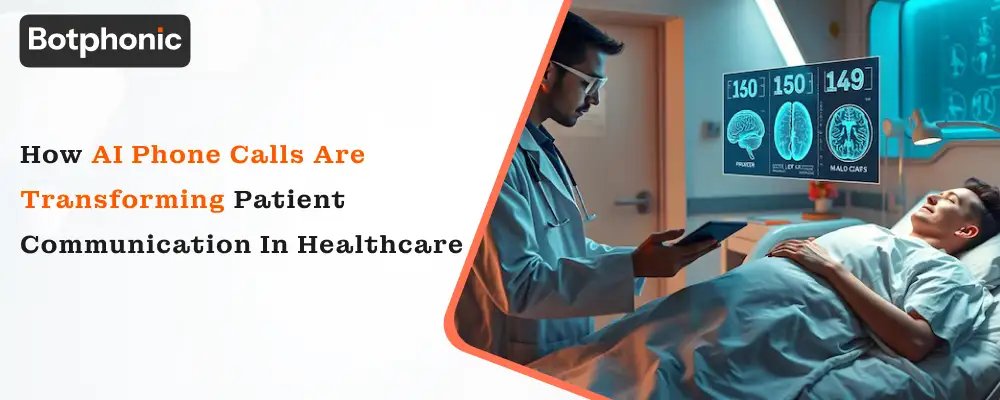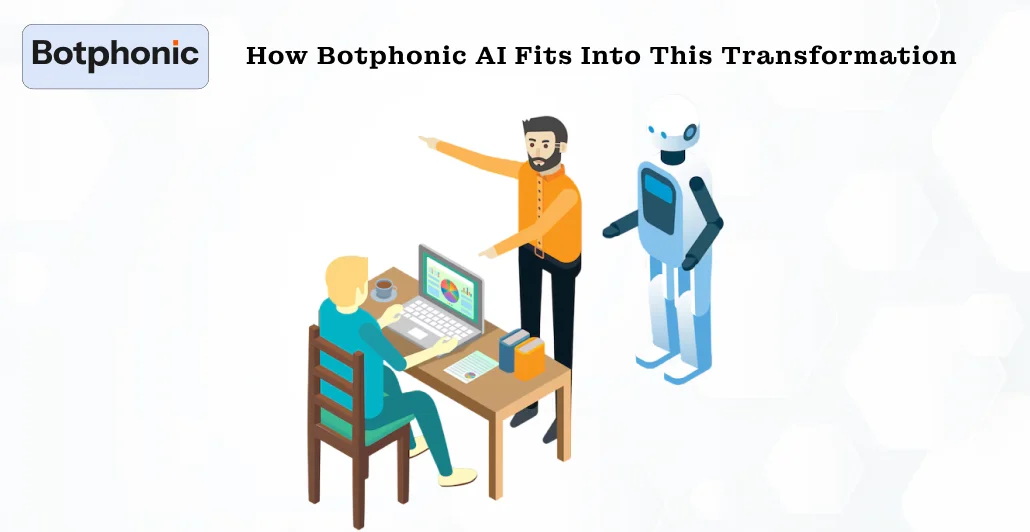
Summarize Content With:
Summary
The blog will discuss how artificial intelligence is revolutionising medical services in healthcare by enhancing accessibility, efficiency, and patient engagement through patient calling. It also explains the way this transformation works, its advantages, existing obstacles, and the implementation of AI healthcare communication in your company with Botphonic AI.
Key Takeaways
- AI-initiated telephone healthcare communication enables medical staff to provide 24/7 patient interaction via phone calls in a normal voice, which is a major factor contributing to patient contentment and reducing the number of appointments missed.
- The connection with appointment booking systems, EHRs, and data processing tools helps make the whole scheduling process more efficient, allowing employees to concentrate on higher-level tasks.
- It is imperative to pick the right platform (with features such as multilingual support, compliance, and sentiment analysis), and Botphonic AI fulfills a good share of these requirements.
- There is still a long way to go for the development of the actual planning stage, with security of information, escalation procedures, familiarisation, and ongoing optimisation being the aspects that contribute to success.
Introduction
Imagine a patient’s midnight call to the clinic, anxiously worrying about a follow-up appointment or a test result, only to hear an immediate response from a responsive voice that understands the request, books a slot, and confirms the details all without waiting in line or leaving a message.
Nowadays, this situation is not so far off into the future anymore due to the rise of cutting-edge AI Call Assistant solutions and state-of-the-art AI Phone Call technology (https://botphonic.ai/ai-phone-call/).
AI-powered telephone patient communication is the technology that quietly yet powerfully transforms the way healthcare is delivered. This blog explores how this revolution is unfolding, the reasons behind the sudden surge, its benefits, challenges, and ways to harness this power in your patient communication strategy, utilising Botphonic AI to bring about real change.
Why is patient communication ripe for transformation?
Healthcare patient communication has been under pressure for a long time. Medical centres are flooded with calls, and the front-desk team faces routine questions (such as appointment directions and insurance) while completing their daily tasks. As stated in one review, “Physicians now spend an average of 15 to 18 minutes with patients; almost half of their clinic day is devoted to documentation and non-clinical work.”
Patients are looking forward to very prompt and easily accessible interactions. One article asserts:
“In a world where people can order groceries, book flights, and transfer money in seconds, long wait times for accessing basic health information are no longer acceptable, especially when health is on the line.”
Meanwhile, the performance of traditional call centres and interactive voice response (IVR) systems is declining: the number of staff is limited, after-hours calls are often unattended, and the “please hold” experience annoys patients, leading to an increase in no-shows. The costs of missed appointments and poor communications are significant.
In such situations, AI-based telephone systems can be considered one of the most promising communication tools: they can handle routine interactions and scale them, while humans are free to deal with more complex care, resulting in an enhanced patient experience.
What does an AI phone call for patient communication look like?

What would an AI phone call for patient communication be like in reality? The breakdown of the healthcare application of the different components behind the technology is given below:
How it works
- A patient either calls or receives a call from a medical institution or a doctor’s practice.
- The AI call assistant software utilises Automatic Speech Recognition (ASR) technology to convert what the patient has verbalised into a written form.
- Natural Language Processing (NLP) not only detects the features of a sentence but also the user’s intention (e.g., “I need to reschedule an appointment” or “I am calling to inquire about my lab test results”).
- The system converts the text response into audio (TTS) by using a voice similar to a natural human one and performs the tasks (schedule patient, send reminder, gather insurance info).
- An application programming interface (API) bridges the service with the healthcare facility’s scheduling/EHR/CRM systems to enable instant updates.
- The machinery allows for intervention by a human operator when necessary (emergency, complex inquiry).
Health-oriented features
- Virtual triage: Through AI, the system can ask discharged patients basic questions from the checklist and identify those who then require a call from a human doctor.
- Virtual Assistance: An AI agent can support the healthcare system by performing the role of a virtual assistant when the need for the following arises:
- Post-discharge check-in: The AI can track patients who require additional assistance after hospital discharge.
- Medication reminders: The AI calling system can remind patients about the medications they need to take.
- Prevention through screening: The AI can identify patients who require specific tests or vaccinations.
- Multilingual Support: Language-based support for a wide range of patients.
- Analytics: Call volume, no-show reduction, patient satisfaction.
Example of how Botphonic AI supports this
Botphonic AI offers modules customised for healthcare: their website mentions that their AI voice assistant is capable of “examining patient information and guiding them within minutes. By understanding reports and sharing insights, the assistant makes it easy for the patient to interact with the suitable healthcare provider.”
Key benefits of AI phone calls in healthcare
| Benefit | Why it matters for healthcare |
| Better access (24/7) | Patients get support anytime rather than waiting for office hours |
| Reduced no-shows | Improves utilisation of appointments, reduces wasted staff time |
| Staff efficiency | Staff freed from repetitive tasks to focus on care |
| Scalability | Larger call volumes are handled without a linear cost increase |
| Analytics & integration | Better insight into operations and smoother workflows |
How Botphonic AI fits into this transformation

As this is a Botphonic AI blog, we should consider the platform as a means to facilitate the above transformation and understand the reasons for its superiority.
Key features relevant to healthcare
- According to Botphonic’s site, its AI voice assistant in healthcare “goes through the patient data and leads them in a couple of minutes. Helping in understanding the reports and giving the insights, patients get to interact with the right healthcare provider.”
- In addition to 24/7 availability and multilingual support (in over 20 languages), they also mention automating tasks such as registration, appointment booking, and back-end billing support.
- The idea of “zero marginal cost AI phone calls” for healthcare is quite explicitly mention on their website: “So, after the installation of the system, the extra calls cost very close to zero… hence, healthcare providers can efficiently communicate with patients without putting a heavy load on the budget.”
- They provide real-time call analytics, sentiment analysis, and integration with CRM/EHR/Calendar.
Why this matters for you
- If your healthcare practice or organisation wants to improve patient communication to become more modern, then Botphonic AI is the voice automation platform you need, not just another generic chatbot.
- Since it is primarily call-base, it caters to the main communication channel for most of the patients (phone).
- Healthcare-specific workflows (appointment booking, reminders, and triage) are support, and the design allows for scaling without a corresponding increase in costs.
- The implementation looks less complicated (there is a free trial, and the setup guide is step-by-step).
How to use Botphonic in your healthcare setting
- Have a pilot program: Select a highly routine call type with a large volume (e.g., appointment confirmations or follow-up calls) and implement Botphonic’s AI calling.
- Keep an eye on key metrics: Including answer rate, call length, no-show rate, and patient satisfaction.
- Broaden to other workflows: post-discharge check-ins, preventive screening outreach, multilingual patient segments.
- Always improve: leverage analytics to refine conversation flows and identify and resolve escalation scenarios where AI is misuse.
- Grow: After you gain ROI and see positive patient feedback, extend the program to other departments or locations.
What if every patient had a personal assistant that answered the calls immediately, scheduled appointments, and did the follow-up, all done by AI?
With Botphonic AI’s smartphone assistant, you can do it right away and see how simple healthcare communication is.
Schedule your free demo today and create a revolution in how your clinic connects with patients.
Try Now!Conclusion
Switching to AI voice calls for patient communication is a significant step in the way healthcare organisations communicate with their patients. Utilising natural voice-based AI, integration with the backend system, and real 24/7 availability allow providers to extend access, lower the number of no-shows, reduce staff workloads, and create a better patient experience.
The AI Phone Call Automation Software guide provides an example of how platforms like Botphonic AI facilitate this change, making it achievable and scalable, and offering a multilingual, analyst-driven, and budget-friendly voice automation solution.
Indeed, the rollout requires a carefully planned integration, compliance, escalation protocols, and continuous optimisation. But a healthcare provider with a defined pilot, measurable metrics, and a partner like Botphonic AI is still able to take action.
If you are looking to revamp your patient communication methods, reduce no-shows, and empower your staff with smart voice automation, then there is no doubt that Botphonic AI should be your next step. Your patients and your team will thank you.

